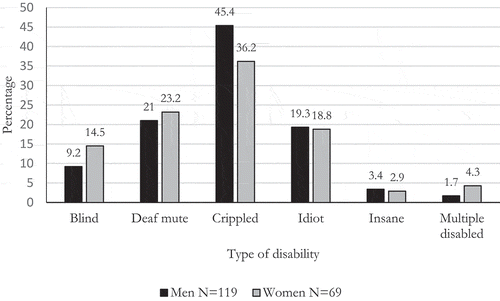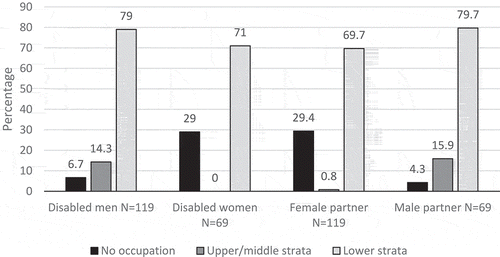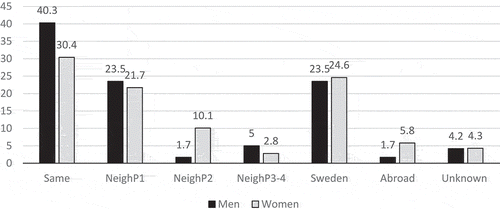Figures & data
Table 1. Categorization of disability based on the marks of impairments in the 19th-century parish registers of the Sundsvall region.
Figure 2. Percentage distribution by type of disability among the disabled men and women (born 1800–1850) who married in the Sundsvall region.

Table 2. Social classification scheme based on the DDB’s occupational codes.
Table 3. Mean and median ages at first marriage among the disabled men and women (born 1800–1850) compared to average measures of the spouses they married in the Sundsvall region.
Table 4. Age gap at first marriage between disabled men and women (born 1800–1850) and the spouses they married in the Sundsvall region.
Table 5. The five most common occupations held at marriage by the disabled men and women (born 1800–1850) and by the spouses they married in the Sundsvall region.
Figure 3. Percentage distribution by social strata based on the occupations held at marriage by the disabled men and women (born 1800–1850) and by the spouses they married in the Sundsvall region.

Table 6. Distribution of social endogamy/exogamy regarding the marriage patterns based on the socio-economic background of the disabled men and women (born 1800–1850) and of the spouses they married in the Sundsvall region.
Table 7. Socio-economic origin (father’s occupation) at marriage of the disabled men (born 1800–1850) and of the spouses they married in the Sundsvall region.
Table 8. Socio-economic origin (fathers’ occupation) at marriage of the disabled women (born 1800–1850) and of the spouses they married in the Sundsvall region.
Figure 4. Distribution of spatial endogamy/exogamy regarding the marriage patterns based on birth parish of the disabled men and women (born 1800–1850) and of the spouses they married in the Sundsvall region.

Data availability statement
For more information about the availability of the data used in this article (19th-century Swedish parish registers digitized by the Demographic Data Base, DDB), visit the below websites at the Centre for Demographic and Ageing Research (CEDAR), Umeå University, Sweden:
https://www.umu.se/en/centre-for-demographic-and-ageing-research/search-tools/

